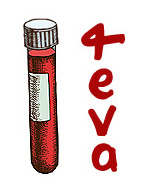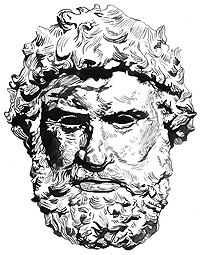from the chronicles of cinematic badassery:
Carbon Mike
3:11 AM (6 hours ago)
"You think you can take me? Yeah, maybe. Straight up, hand-to-hand, you got a shot—maybe. But maybe I wear a blade. Maybe I got a .45 cocked and locked to shove up your ass, you ain't considered that, have you? Hey, you want to know something? You ain't like Elwood here, you got guts. Guys like you get all the medals."
—Scott Glenn as First Sergeant Robert Lee in the movie "Buffalo Soldiers"
Hope you're well and had a productive blog hiatus.
I'm working on scenario design for my RPG and I'm visiting battles/wars this week. I listed out my thoughts on the topic but there were a handful of statements I made that I'm not sure if they are true, particularly as they relate to historical periods. I submit the following for investigation - it's very important to know where I'm wrong, particularly the bold statements. Note that I'm using "smaller army" here to mean defender. There's a whole category I'm ignoring, like Alexander or the Mongols, where the aggressor had smaller numbers. It would be helpful to consider that too.
Thank you!
I have descended,
Polynumnuts
I will mark my comments like so, [with brackets.]
• Battle is largely consensual, meaning that in most cases both armies must choose to offer battle for it to occur.
• [Make provisions for skirmishing and meeting engagements, which is where most individual combat happens from earliest antiquity to the American Civil War. See Xenophon’s Anabasis]
• At the logical extreme, a completely passive army can have all of its supply lines cut off and be starved to death
• [Yes, see Fort Donaldson and Forest’s retreat in 1862]
• In practice, both armies are always sending out smaller units (usually cavalry, but mages can do the trick as well) to harass each other's supply lines
• [Mages can be used to represent spies, scouts and artillery from historic periods]
• There's limits to how far these harassing units can go without being trapped, unless lead by an exceptional commander
• [a skirmishing ability for units and modifier for commanders would help. Some good battle commanders are no good finessing meeting engagements and screening actions]
• If an army breaks off an engagement, the other can pursue
• [screening resolution rolls should be made]
• The pursued army can usually offer battle on advantageous terrain
• [This was the case in the American Civil War but not in much of ancient warfare, such is Teutoberg Forest and in Xenophon’s ordeal. What matters most is if it is home ground.]
• Typically the larger army is trying to break through to a strategic objective
• [Supply problems tend to demand access to fresh forage.]
• A smaller army can operate away from its supply lines further and longer than a larger army
• [Type of force is just as crucial at medieval scale, with irregulars, barbarians and lighter troops often foraging for themselves and heavier troops. See the movie, The Last Valley]
• Campaigns are often a series of battles where a larger army is moving into the territory of a smaller army.
• [American Civil War and Greco-Persian Wars were among the best case studies.]
• Why is this so? In strategic equilibrium the larger army attacks because the side with the smaller army has more resources and will eventually have a larger army with a higher rate of growth
• [Armies only grow directly from resources in fantasy. Think of the force as a machine and supplies food. Even if gassed up, taking that thing off road or racing it will wreck it, not build it.]
• The two scenarios:
•
o The smaller army is growing faster (strategic equilibrium). This lasts until a turning point is reached:
o
the smaller army is utterly destroyed and the political scwherpunct [I love this rule in WWII games] is taken
The smaller army outgrows the larger army
The larger army does sufficient economic damage, so the smaller army no longer grows faster
• [Both armies start to erode and continue to do so so long as on campaign unless replenished from outside the theater.]
o The larger army is growing faster (strategic imbalance)
o
Once this point is reached victory is assured for the larger army
[Shitty armies never have a sure win. Morale is fleeting and can be corroded.]
The tragedy of truces sets in (the side that wants to negotiate has nothing to offer, and people on both sides die needlessly)
At this point the only hope for the smaller army is an exceptional commander who can use mobility to enervate the larger army, destroy it, and still have the resources to inflict sufficient economic damage before on the enemy
[In most periods economic damage is incidental, such as trampled grain. In medieval times and in ancient Greek polis men will marshal to defend their grain rather than die of starvation over the winter]
In this stage the weaker combatant is better served by obfuscating its political schwerpunkt, denying its opponent victory through superior force of arms, and waging insurgency against the enemy's political structure
[With muscle-powered armies, insurgencies are weaker on the offense and more tenacious and harder to stamp out than we have seen in the 20th and 21st centuries.]
• Typically the smaller army gets to choose where to fight, and might get some kind of terrain advantage
• [Quality of command is just as big a factor, as is home ground. This should be a command skill with modifiers.]
o Top of hill
o On a narrow ford / bridge of a river
o Edge of a forest
o Mountain pass
o Fortress / walled city
• If the larger army disengages it may go to one side or another, and search for a way to get to a strategic objective. In this case the smaller army is usually able to choose advantageous terrain, if it can determine where the larger army is going.
• [What matters most is screening ability, familiarity and command. If the bigger army has a lot more and better light cavalry, the small army may be blind.]
o Armies use screens to buffer their main forces and to obfuscate their movements
o [This could be interactively competitive.]
o On the march, armies often split their forces to facilitate foraging, meaning that smaller armies can concentrate their strength earlier than larger armies
o There is a time to how long an army can remain fully concentrated, like flexing a muscle
o The defender must find out where the larger army intends to attack (mission)
o [Large primitive forces often give up initiative due to lethargy stemming from above factors.]
• There is a lot of marching
• [18 miles a day was the Roman standard, a high one. The Macedonians did 30 and even 60 a day over open terrain.]
• Over the course of a war, there is a period of mobilization, where every resource is brought to bear on the conflict
• [Rarely in pre-modern settings]
• At some point the maximum mobilization is achieved; every available solder has been called up
• [Not until the mid 1800s]
• Political organization has a lot to do with mobilization (efficiency, speed, depth); maybe more than demographics
• [Feudal forces and tribal levies cause much friction here.]
o Rulers can extend the normal limits of mobilization with conscription and by granting various political or economic freedoms (which often backfires) [Especially in feudal and tribal settings.]
• Larger countries take more time to mobilize, their growth rate is slower
• [With imperial forces it depends on social efficiency. In feudal settings they muster piecemeal.]
• Economic damage effects how many soldiers can be maintained in the field
• [In ancient Greece and medieval Europe economic damage was easily achieved fighting in grain fields. See Victor Davis Hanson in Wars of the Ancient Greeks.]
• To defeat an army that refuses to fight, push it back and inflict economic damage. Eventually it will have to fight. Your army will grow stronger and their forces will hit an economic ceiling
• [Such armies rarely maintained campaigns unless they were raiding like the English in the 100 Years War of exploring like Alexander and the Mongols. It was more like a natural disaster. In 1600s England unpaid troops just scattered and started selling their gear, eventually some selling themselves to avoid starvation and others turning bandit. See CV Wedgewood the thirty Years War.]
• It is very difficult to defeat a pastoral society through economic damage; they can always retreat deeper into the steppe and take their economy with them; as long as they have scouts and some warriors, a pastoral society can't be destroyed by an agricultural society
• [Only until the industrial age. Could magic be used in the same way as the train and rifle?]
• A swift moving pastoral society can wipe out another pastoral society by killing its livestock and taking their women
• Although agricultural societies have more people, they cannot eradicate pastoral societies. When agricultural societies have the advantage, pastoral societies retreat. When pastoral societies have the advantage (usually by confederating under a warlord) they conquer agricultural societies. Therefore, pastoral societies have inevitable advantage
• [The most consistent premodern constant in war.]
• An industrial society may be defined as one that can project its supply lines into the deep steppe, thereby being the first type of settled society that can defeat a pastoral society. The rail defeats the horse.
• In RPG's, the warpgate takes the place of the rail
• Dispersed units do economic damage faster
• [When enemies. Invert for friendlies]
• This damage may not be apparent until maximum mobilization occurs
• If the smaller army disengages it usually moves back, sometimes surrendering a strategic objective
• At some point the supply line for the advancing army is stretched to the maximum; it can go no further without exhausting itself
• [This has much to do with staffing. See Tyler’s defeat of the Shawnee about 1814 for an example of wilderness supply chains.]
• When this happens, a period of consolidation occurs; the advancing army secures its supply line, builds outposts, rests, equips, etc.
• A secure supply line means more fortification. Why? You want fewer people carrying more food, because food is eaten on it's way to the front. Fewer people carrying more food means more intermediate fortifications along the way, where food can be secured against harasses and raiders with minimal consumption, because walls don't eat. You want more food carriers, and fewer food defenders. Local garrisons can rally and swarm the intruders, driving them off with fewer men than if they didn't have fortifications. Food carriers can also shelter within fortifications if they hear of raiders nearby, or house food while they take up arms, until the raiders are driven off, thereby conserving the food. A point is reached at which enough fortification deprives raiders of any food at all, and an area becomes completely secure.
• [River supply is as important to premodern war as rail and road in modern war. See the Last Turkish siege of Vienna, when loss of riverine control prevented bringing up siege guns.]
• Destroying a supply line means destroying a bunch of little forts and depots, which in of itself doesn't do that much economic harm. However, it allows you to raid more deeply into enemy territory, which does. Now the enemy needs more soldiers to carry less food, and his point of maximum extension shortens.
• Destroying a supply line must be followed up by deeper raiding, or it is a waste of effort
• [See Forest’s campaigns in Tennessee for an excellent example. It is not a defensive waist, especially against feudal and imperial tribute armies.]
• An area where two armies are operating has its local economy destroyed (depleted?) pretty quickly
• [A day can ruin a harvest.]
• There is a limit to how long an army can forage in one area. Typically this pressures the larger army into seeking decisive engagements, while the smaller army is satisfied with dragging out battles into inconclusive engagements
• [See the Empires in Arms foraging system, which awards foraging ratings to areas.]
• A smaller, faster army lead by an exceptional commander can use speed and audacity to attack a larger army's supply lines keeping it slow and enervated, until it is slow and weak enough to be destroyed in derail; this takes both courage and patience, qualities rarely found together in abundance
• Occasionally, armies bump into each other by accident. These types of battles are characterized by each army calling in for reinforcements in the area, which arrive over the next few days, as well as friendly fire
• [Screening abilities could govern this resolution.]
• The smaller army usually has less marching to do, benefitting from interior lines, and can move feed faster with less exhaustion
• Armies hauling siege weapons tend to move slowly
• Certain things may count as economic disruption (repairable damage)
• Undead armies know neither fear, nor hunger, nor weariness. They might not even be that hard to fight, but people hate them because they aren't subject to these strategic constraints.
• [The 2015 Baltimore Riots established the zombie operational ceiling at about a week.]
• Larger armies can induce smaller ones by burning villages, salting fields, etc.
Statistics for extended contests / campaigns
• Maximum mobilization, total troops each side can raise
• Speed of mobilization
• Economic ceiling (reduced by economic damage)
• Maximum extension (one reason for strategic lulls, as supply lines are constructed)
• Current size of forces (affected by battles)
Early phases of a war, features
• Both sides looking for a decisive, early, knockout blow
• Sometimes the war actually ends here, especially pastoral societies (the loser leaves the territory)
• Not too late for diplomacy
• Unstable front
• [Fronts are modern concepts based on state infrastructure.]
• Fortifications not yet erected everywhere, requires persuasion because locals don't believe war will last very long
• [Forced fort maintenance was a cause of Bacon’s Rebellion in 1676. The locals knew the forts to be useless against raiding savages and that they were instruments of state control not subject protection but subjugation projection.]
• Results of this phase tend to determine the kind of war it will be
•
o Where most of the action will be
o Symmetrical: large front with posturing armies looking for advantage
o [More like gangsters trying to find each other in the woods.]
o Asymmetrical: the larger army takes the major cities, but doesn't have control of the countryside, can't find the scwherpunct to bring the war to a close
Symmetrical, Middle phases, feature
• If no knockout blow is achieved
• Front largely stabilized (equilibrium established)
• Fortifications constricted
• Beginnings of blockades / sieges
• Looking for ways to break the stalemate
•
o Alternate theaters
o [A favorite gambit in early modern state wars.]
o Super weapons, macguffins
o Allies
o Monster armies / supersoldiers
o Armies posturing around each other
• There will be several times when the side with abundant strength will concentrate its forces in one area and attempt to push through. Often these offensives are checked.
• [Think events and battles. Fronts are rally modern concepts.]
• Longest phase as various tit-for-tat maneuvers roughly balance each other out
• Magical resources shifted from winning battles to improving logistics
• By now, common soldiers are more experienced
• Behind the lines commando raids to disrupt supply lines/ facilities; this is an ongoing background noise to the war
• [Think 30 Years War style foraging battles. Raids are disastrous risks even in early modern times. Rogers Rangers 1750s and Morgan’s Riders and Joe Shelby’s horse army 1860s met grim fates.]
• Ends with some kind of decisive battle
•
o A key city is taken
o A huge, attritional battle crushes the will to resist
o [These two outcomes are what ancient and medieval war often focused on. Do not forget that most pre-modern wars were attempts at social decapitation, in which the target is the head of state as combatant. The wars of Alexander, of the Conquistadors and of the Norse and Normans were prime examples. Rome, through its systemization and avoidance of hero kings in the Republican and most of the Imperial phase, was organized to inoculate itself against this dynamic, which is why it was so formidable and long lived. In the end though, it became a battlefield across which hero kings like Constantine, and Attila waged war in the old way.]
Asymmetrical war, middle phases, features
• Large side searching for various measures of effecting a schwerpunkt
• Smaller side attacking political core
• The asymmetrical middle phase is often extremely long
Late phases, features
• Big split between utterly green recruits and a small core of wily veteran survivors, very little in the middle
• Economic devastation
• [See C.V. Wedgewood’s Thirty Years War.]
• The losing side generally knows it has lost, and is trying to negotiate a truce; the winning side, knowing it has won, won't accept anything less than complete surrender which the losing side won't accept (the tragedy of truces)
• [This is a feature of industrial and imperial settings. In feudal settings peace tends to be more easily attained.]
• Often one final, hard fought battle waged by the losing side to prove its honor / valor, or else a bitter defense of the capitol / last remaining fortress
• Defections and assassinations typical for this phase
• Very strange, risky, self-destructive super weapons released at this point
• Various kinds of desperation moves / suicide attacks
• Morale very low on both sides as no one wants to die in a war whose fate has already been decided
• [Consider holy orders for extended conflicts.]
• First bickering with allies over spoils of war
• Portents of the future: culture, technology, culture to change as a result of war
How to get the right feeling
• Reducing war to number / economics = modernist mindset
•
o We want a Bronze Age Mindset (lol)
o You do not go to war to "protect the economy"
o You go to war because your god demands it
o War does not end because of "economic exhaustion"
o It ends because you lost the favor of the gods
o You do not cause "economic damage"
o You defile temples, destroy shrines, spoil fields, slay priests, shatter relics, and burn scriptures
o [Raising monuments and trophies and having triumphs]
o A country does not "mobilize"
o [Class honor more than “national” attachment is a big one for smaller scale wars in medieval settings.’
o It answers the demands of gods
o Economics is The god with no name.
o You did not win because you were stronger than the enemy
o You chastised them because they worship false gods
• The spiritual origins of a conflict effect your perceptions of the opponent
•
o A Matter of Honor: In some cases war follows insult to honor. The chieftain doesn’t hate his enemy, but the gods demand action. He takes retribution and honor is served. The conflict usually ends after one or two battles. Proving one’s bravery before his brothers is the focus, less so any material objective. Tribes who squabble over honor will confederate when greater threats emerge.
o [This type of thing is often the catalyst for “seasonal” or annual tribal warfare. The Appalachian Trail or Long War Way, basically existed for this purpose.]
The weak should fear the strong: Sometimes a large kingdom, jealous of its neighbor’s riches, devours a small one. Such is the way of the world – but the aggressor can be stopped if the war proves too costly.
[As with Scotland and England, such annexations can result in centuries of wars and revolts.]
Against the Blasphemers: In other conflicts the enemy is a devil-worshipper or some manner of blasphemer. He defiles temples, inverts rituals, and sacrifices children. His very way of life insults the gods, and every last vestige of his vile existence must be erased from the earth.
[This was good for a thousand years of religious war between Islam and Christendom. The modern concept of “fronts” might best apply with religious war.]
Cleansing Fire: Sometimes, a ruler becomes possessed by the god of war, and feels compelled to burn his name in the pages of history. He is like a wildfire that consumes the underbrush to keep a forest strong. He pushes his empire from sea to sea, incorporating entire peoples as he goes. He respects their skill in arms even as he razes their cities to the ground. This man is simultaneously hated, feared, and admired. His conquests may inaugurate a glorious dynasty, or die with him. He is stopped only when his genius is matched by another.
[I like this the most. Hannibal had his genius matched by Scipio, but usually booze, bitches, backstabbers, old age and wrecked health is all that stops guys like Attila, Tamejun, Alexander and Cortez.]
[Sounds like fun.]











